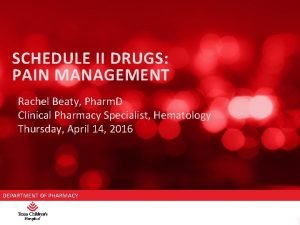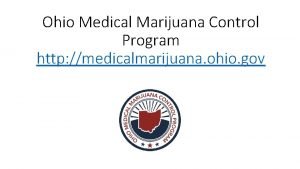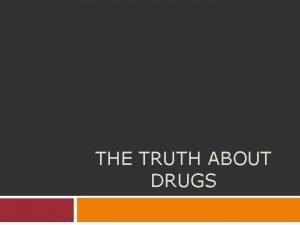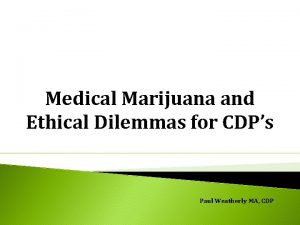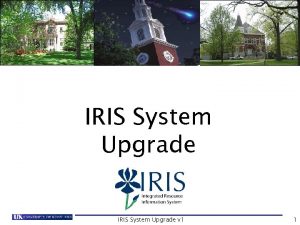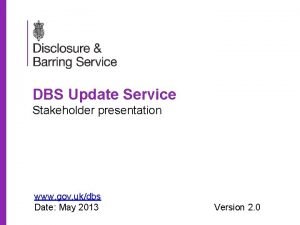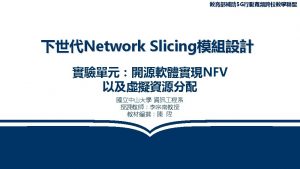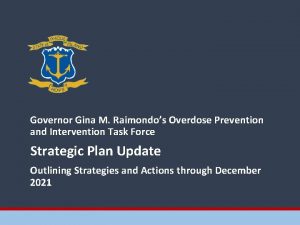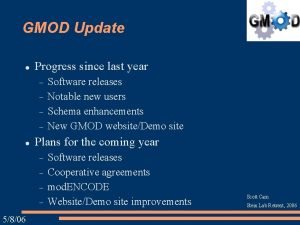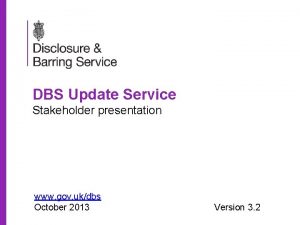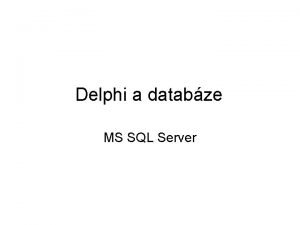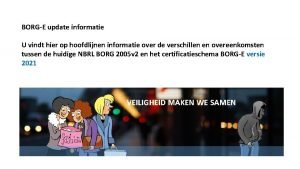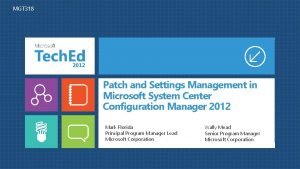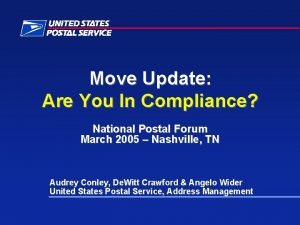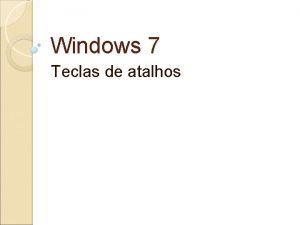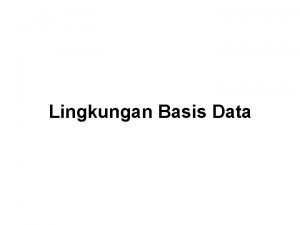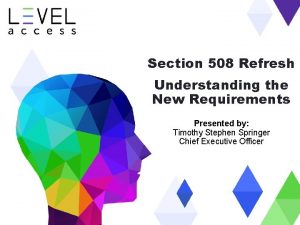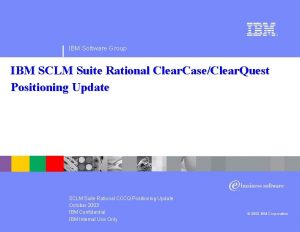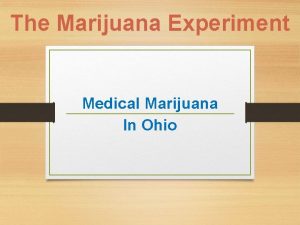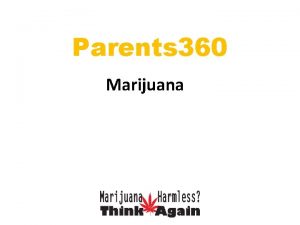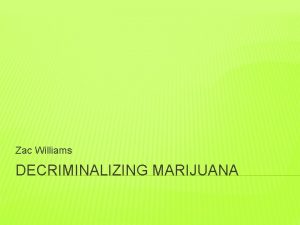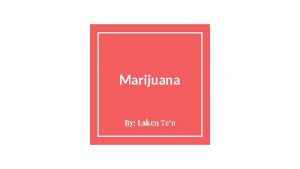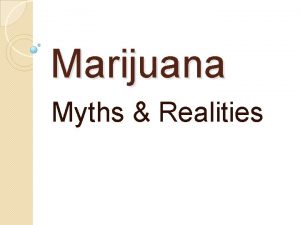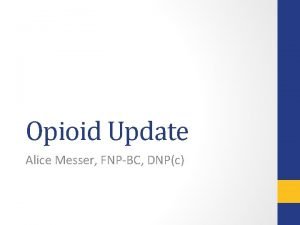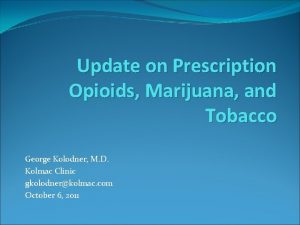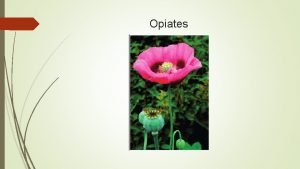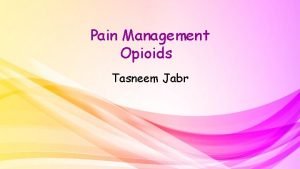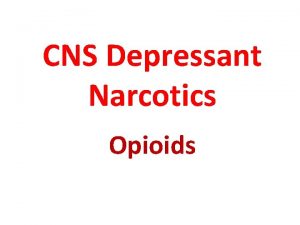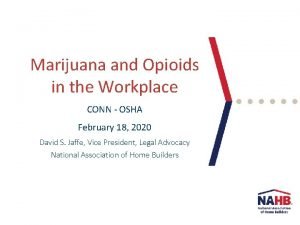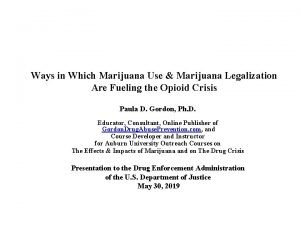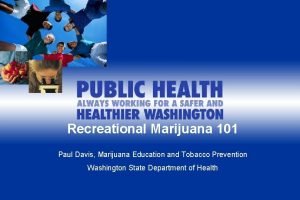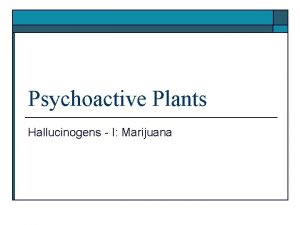OPIOIDS MARIJUANA AN UPDATE ON THE IMPACT TO


























































































- Slides: 90

OPIOIDS & MARIJUANA: AN UPDATE ON THE IMPACT TO USDOT DRUG & ALCOHOL TESTING PROGRAMS 35 th Anniversary Spring Conference Community Transit Better Together Robbie L. Sarles, President, RLS & Associates, Inc.

New Challenges ♦ ♦ ♦ Trends in Use and Positivity Rates Consequences of Recent Regulatory Change ○ Expansion of Opioid Panel and Safety Risks Marijuana Trends and Impact on the Workforce

MIS DATA * Partial data (90%)

MIS



MIS


MIS DATA 92%

MIS DATA






FTA RANDOM TESTING RATES 2018 2019 Drug Testing 25% 50% Alcohol Testing 10%

Random Testing Rates ♦ Random DRUG testing rate has increased to 50% ○ ○ Effective: Jan 1, 2019 Applicability: All employees covered by FTA drug & alcohol regulations ♦ Random ALCOHOL testing rate remains the same – 10% ♦ May require FTA D&A Policy revision ♦ REMEMBER: ○ If your random pool “mixes” employees covered by different USDOT – Agencies, you must test entire pool at highest rates

2018 Regulatory Changes ♦ “The What? ” ○ ♦ “The When? ” ○ ○ ♦ 49 CFR Part 40 is USDOT’s D&A regulation covering testing procedures updated Nov 2017 – Final Rule published in Federal Register Jan 1, 2018 – Effective Date for all changes The Who? ” ○ ○ ○ Applicable to entire DOT industry (FTA, FMCSA, FRA, FAA, PHMSA, USCG, etc. ) ANYONE subject to 49 CFR Part 40 Employers, MROs, SAPs, Collection Sites, etc.

Summary of Changes ♦ ODAPC List-Serve ○ All service agents REQUIRED to “subscribe” ○ Sign-up via https: //www. transportation. gov/odapc/getodapc-email-updates ○ Need to be able to document evidence during audits / reviews § Save a copy of the confirmation email

Summary of Changes ♦ Drug Testing Panel Modifications (continued) ○ ○ “MDA” added to screening test “MDEA” removed

Summary of Changes ♦ MRO Verification Process ○ Clarification of the term “prescription” § ○ Prescription (Rx) must be consistent with Controlled Substances Act (CSA) MRO-ordered additional testing § Authorized without prior ODAPC consent • Meth false positives due to Rx/OTC meds • Illicit THC vs. Marinol

Opioid Panel ♦ Drug Testing Panel Modifications ○ ○ “Opiate” changes to “Opioid” Four new opioids added to testing panel Chemical Name Common Brand Names Hydrocodone Norco® ; Vicodin® ; Lortab® Hydromorphone Dilaudid® ; Exalgo® Oxycodone Oxycontin® ; Roxicodone® ; Percocet® Oxymorphone Opana®

“Safety Risk” Determination Process ♦ MRO Rx Verification Process ○ MRO release of information – Medically unqualified / Significant safety risk § Step 1 – Verify test result § Step 2 - Initial MRO determination • MRO notifies employee of medically unqualified / significant safety risk § Step 3 - Five-days for prescribing physician to contact MRO • Employee facilitates contact

“Safety Risk” Determination Process ♦ MRO Rx Verification Process (continued) ○ MRO release of information – Medically unqualified / Significant safety risk (continued) § Step 4 – Prescribing physician statement to MRO § Step 5 – Possible employer notification • Based on outcome of Steps 1 - 4

Industry Response to Today’s Challenges ♦ ♦ ♦ NOT Required by USDOT, FTA or Any Other Modal Administration NOT A Regulatory Requirement Addresses Issues That Might Already Be Covered Under Employer’s Own Company/Agency Authority ATTENTION: ANY TEXT WHICH IS BLUE IS MEANT TO INDICATE THAT IT IS NOT A USDOT, OR USDOT-AGENCY REQUIREMENT/REGULATION. THESE PROVISIONS WOULD BE BESTPRACTICES/SUGGESTIONS AND UNDER THE AUTHORITY OF THE EMPLOYER

Workplace Impact ♦ Policy Revisions – BEST PRACTICES (NOT REQUIRED BY USDOT) 1. If your policy currently has a section on Rx/OTC medication use § Update to address MRO determinations of “Medically Unqualified / Significant Safety Risk” 2. If your policy DOES NOT have a Rx/OTC medication use section § Consider adding a short paragraph

Workplace Impact ♦ “Medically Unqualified / Significant Safety Risk” ○ Final word is the MRO’s DISCRETION ○ What are the REAL implications? § § § ○ Access to prescribing physician Expiration of Rx No recent contact to prescribing physician What to do when/if you get the phone call § This is 100% employer’s determination (No USDOT regulation) • Unless USDOT - CDL medical standards apply

Workplace Impact ♦ “Medically Unqualified / Significant Safety Risk” ○ Employers should be pro-active in creating a “Fitness-for -duty/Wellness” policy (NOT A USDOT REGULATION) ○ Legal/Union/Collective Bargaining Concerns

Implications ♦ MRO Approach To Decision Making Process Is Not Defined In the Regulation ○ MRO discretion based on medical judgement § ODPAC Guidance Forthcoming ○ MRO philosophy, assessment of liability and risk management practices will influence approach ○ Case-by-case determination ○ MRO Contact with Health Care Practitioner Can Be Contentious

Implications ♦ Need to Navigate Differing Medical Opinions ○ MRO ○ CDL Medical Examiner ○ Prescribing Health Care Practioner ○ Other

Implications ♦ Possible MRO Determinations ○ ○ Silent—No safety risk, no employer knowledge, no employer action Notification of safety issue—Employer action § Follow procedure for CDL standard violation if appropriate § Liability Considerations § Human Resource § Legal Considerations § Collective Bargaining

Best Practice ♦ ♦ ♦ Proactively Discuss Philosophy and Procedures with MRO If MRO Philosophy Is Inconsistent with Employer Philosophy or Intent of Regulation, Identify New MRO If MRO Is Unwilling or Unable to Perform This Function, Identify New MRO Define MRO Safety Issue Notification Procedures, Documentation and Timeline Negotiate Cost of MRO Safety Assessment Do Not Accept Employee Medical File Dump From MRO

Implications ♦ Employee Facilitation of Prescribing Physician/MRO Contact ○ Employees May Have Difficulty Accessing the Prescribing Physician In a Timely Manner § If More Than 5 Days Are Needed To Obtain an Appointment or Otherwise Get In Contact § The Prescribing Physician Is Unaware or Does Not Understand the Importance of the Contact § Employee Has Had No Recent Contact or Ongoing Relationship with the Prescribing Physician § Employee Does Not Know How to Facilitate the Contact Between the Physician and the MRO

Best Practice ♦ Assist Employees In Being Proactive ○ Educate Employees on Safety Risks of Rx ○ Provide A Summary of Regulatory Changes § ODAPC Notice ○ Review New/Revised Employer Policy ○ Define Process and Provide Guidance On How to Notify Prescribing Physician to Contact MRO

Best Practice ♦ Encourage Employees to Obtain Updated Rx ○ Current Rx Is More Than One Year Old ○ Rx States “Take As Needed” For An Injury That Is No Longer Being Treated By the Prescribing Physician ○ Employee Does Not Have an Ongoing Relationship with the Prescribing Physician § ER/Urgent Care or Doc-in-a-Box Physicians

Best Practice ♦ Encourage Employees to Obtain Updated Rx (cont. ) ○ Revisit Treatment Options With Prescribing Physician for Chronic or Reoccurring Conditions To Minimize Safety Impacts While Not Compromising Medical Care ○ Encourage Employees Using Opioids to Discuss Dosing Option with Prescribing Physician § Timing § Dosage § Alternative Pain Management Options

Best Practice ♦ Address Possible Withdrawal Implications ○ Illness/Injury Treatment Options ○ Cold Turkey Withdrawal May Be Harmful to Employee and Create a More Significant Safety Risk ○ Medical Assistance in Managing Possible Withdrawal

Best Practices ♦ Provide Employees with a Physician Rx Medical Authorization Form ○ Job Description Highlighting Safety-Sensitive Duties ○ Area for Prescribing Physician to Indicate Possible Safety Risks With Corresponding Restrictions, If Any ○ Notification that Prescribing Physician May Be Contacted By MRO If A Safety Concern Exists

Best Practices ♦ Inform Applicants of Possible Prescribing Physician/MRO Contact Requirement ○ Provide Explicit Directions As Early on In the Hiring Process As Possible ○ Emphasize That a Valid Rx Does Not Necessarily Mean Disqualification. ○ Rx Is Only An Issue When It Rises to the Level of Safety Risk.

Implications ♦ Employer’s Response Not Defined ○ ○ ○ Assessment of Nature and Scope of Safety Risk § Short-term, Long-term, Permanent § Course of Action/Remedy Monitoring Process and Revaluation Medical Advisory and Decision Making Process Employee Consequences And Due Process Documentation, Record-keeping, and Confidentiality Liability and Risk Management

Employer Challenge ♦ Best Practice Is to Develop An Effective Rx Fitness-for. Duty Program ○ A program that minimizes the associated impairment risks of taking legally and illegally obtained prescription medications while performing transit–related, safetysensitive functions

Best Practice ♦ Establish a Fitness-for-Duty Program ○ Policy ○ Consequences ○ Medical Review of Employees Deemed to be a Safety Risk ○ Procedures ○ Employee Education ○ Documentation, Reporting, Confidentiality

Legalization of Marijuana Trends--Usage Trends—Potency/Consumption Workplace Impact Questions Contact Information

Marijuana ♦ Product of the cannabis (Sativa or Indica) plant ♦ Contains THC and other compounds ♦ THC is the main psychoactive chemical that produces the “high” ♦ CBD is another compound commonly sought after from the cannabis plant

Methods of Use How Do People Use Marijuana? ♦ Smoke ○ Joint, pipe, bong, blunt, etc. ♦ Vaporize ○ Vaporizers, E-cigs, Vape-pens ○ Collect THC in vapor, which is then inhaled instead of smoke ○ Typically THC oil but can be leaf form as well ♦ Edibles ○ Not just your **grandma’s** pot-brownie any more

Common Names

Common Names

Common Names ♦ Cannabis, Marijuana, Weed, Pot, and on…… ○ Business industry leaning toward “Cannabis” ♦ Differ based on demographics, geography, type of product, etc. ♦ Curious observation: ○ Legalization Increases = “Whacky” Names Decrease

Illicit THC Potency Over Time 1970 = 1995 = 2000 = 2005 = 2010 = 2015 = Has THC in illicit marijuana gone UP or DOWN since 1970?

Illicit THC Potency Over Time 1970 = <1% 1995 = ~ 4% 2000 = ~ 5% 2005 = ~ 8% 2010 = ~ 10% 2015 = ~ 13% are s t c u prod C H al T c i HC d T e M % nd - 30 a l a % 0 n 2 o i be o t Illicit Potency Over Time creat. THC e d R n u o • f C y H l r T a l + u reg 80% e b n s ca e t a r t ncen o c C • TH Has THC in illicit marijuana gone UP or DOWN since 1970?

Recreational, Medical and Decriminalized ♦ What does “Recreational” Marijuana mean? ○ How many states have passed “Recreational”? § 10, plus D. C. ♦ What does “Medical” Marijuana mean? ○ How many states have passed “Medical”? § 33, plus D. C. , Guam, and Puerto Rico ♦ What does “Decriminalized” Marijuana mean? What about CBD? ♦

Recreational, Medical and Decriminalized Medical CBD

Cannabis Use Trends

Cannabis Use Trends

Current Trends in Workplace ♦ ♦ U. S. Workforce Testing Positive for Drugs Has Steadily Increased Over the Last Three Years to a 10 Year High – 4. 0% Post Accident Positivity Increased 6. 2 Percent in 2015 from 2014 Rates and Increased 30 Percent Since 2011 Source: Quest Diagnostics

Current Trends in Workplace ♦ ♦ ♦ Post Accident Positivity for Safety-Sensitive Workforce has Risen 22% Between 2011 and 2015 “The 2015 Findings Related to Post-Accident Testing Results Should be of Concern to Employers, Especially Those with Safety-Sensitive Employees” 2016 Results Are Expected to Be “Alarming” Source: Quest Diagnostics

Colorado Experience ♦ ♦ Marijuana-related Traffic Deaths ○ Up 154% between 2006 and 2014 § No Conclusion Regarding Causal Factors or Impairment § Alcohol and Other Drugs Present in 66% of Accidents ○ Proportion of Total Fatal Accidents Rose From 6. 92% to 19. 26% Emergency Room Visits “Likely Related” ○ Up 77% between 2011 and 2014

Popularity and Acceptance ♦ ♦ ♦ Move From Obscurity to Mass Popularity Outward Acceptance and Expectation of Use Explicit Disregard for Public Consumption Prohibitions Unknowing Consumption Prevalent Smell Secondhand Smoke





Product Trends: Increased Potency ♦ ♦ Highly Potent THC Concentrations Extraordinarily High THC Levels ○ ♦ ♦ 30 -90% More Intense Physical and Psychological High Common Names Vary Regionally ○ ○ ○ 710 (“OIL” flipped and spelled backward) Dabs (Dabbing) Wax; Honey Oil; Budder; Shatter

Product Trends: Edibles ♦ Edibles “coffees to cooked meat, purees to puddings” ○ More and more varieties ○ Low THC dosage edibles marketed toward “Beginners” ○ Cannabis-infused products • Distillate Oils (no odor/taste) ○ Beverages § Including both THC and CBD

Product Trends: Edibles ♦ ♦ High Potency Delayed Reaction Potential for Overdose Unknowing Consumption

Product Trends: Mainstreamed Products

Basic Information

Product Trends: CBD ♦ Cannabidiol (CBD): ○ Many forms, oil is most popular ○ Touted as “non-intoxicating/non-psychoactive” ○ Medical Uses § Heavily studied for its use in wide variety of health issues § Most significant and reliable evidence showing effectiveness for epilepsy • 2018 - FDA approved CBD medication for 2 limited health conditions

Product Trends: CBD ♦ Cannabidiol (CBD) (continued): ○ Workplace impacts: “If I use CBD oil, will I test positive? ” § USDOT tests for THC, not CBD § However, most CBD products have varying levels of remnant THC § Some CBD products have up to 5% THC § Other CBD products have 0. 3% THC § If THC is found above cut-off levels, USDOT test will always be positive (irrelevant if THC came from use of CBD product)

Product Trends: Marijuana Vape Pens ♦ ♦ Near Zero Odor of Marijuana May Seem Like Regular E-Cigarette

Product Trends: Marijuana Vape Pens ♦ Vaping continues to rise ○ More than 30% of all cannabis sales in California in 2018 were vapes ○ Lower perceived health risk ○ Many state medical marijuana laws required vape or only

Product Trends: Marijuana Vape Pens Product Trends ♦ Vaping (continued) ○ THC concentrates: § Highly potent THC levels § common names include • Wax, shatter, 710, honey, budder • “dabs” “dabbing”

Trends ♦ “Weed Weddings” ○ Edibles ○ Cannabis bars ○ Gift bags ○ Designated areas for use ♦ “Bud and Breakfast” ○ www. budandbreakfast. com

Federally Illegal ♦ THC is still Federally illegal… USDOT is a Federal testing ♦ “Prescription” / medical recommendation for Marijuana ○ Will NOT save anyone from a USDOT positive test result ○ For USDOT testing, prescriptions must be consistent with the Federally mandated “Controlled Substances Act” (CSA) ○ Marijuana (THC) is Schedule 1 under CSA = CAN’T LEGALLY BE PRESCRIBED

Drug Testing Implications ♦ ♦ Federal Government Does Not Recognize Medical or Recreational Use of Marijuana ○ Except for Marinol State Law Is Superseded by Federal Law Marijuana and Its Metabolites Remain on the DOT Drug Test Panel MROs Given Clear Direction—Marijuana Positives are to be Verified as Positive

Marijuana As Schedule I Drug ♦ Marijuana Remains a Schedule I Drug ○ Pressure to Downgrade Met With Strong Opposition Specific § Insufficient Evidence to Show that Marijuana’s Known Risks Outweigh Any Specific Benefits Use Might Offer

Marijuana As Schedule I Drug ♦ Drug Enforcement Agency: Marijuana has No Currently Accepted Medical Use ○ Chemistry is Not Known and Reproducible ○ There Are No Adequate Safety Studies ○ There Are No Adequate and Well-Controlled Studies Proving Efficacy ○ The Drug is Not Accepted By Qualified Experts ○ Scientific Evidence is Not Widely Available

Marijuana as Schedule I Drug ♦ More Research Needed ○ Relaxed Restrictions on Research

Trends: Federal Changes? ♦ Possibility of lowering the CSA schedule of THC ○ Currently it is Schedule 1 ○ If this happens, big repercussions in D&A testing industry

Impairment ♦ Marijuana Significantly Impairs ○ Judgement ○ Motor Coordination ○ Reaction Time

Impairment ♦ No Accepted Quantification Levels Correlated to Impairment ○ Fat Soluble--Stored in Fat For Extended Period of Time ○ Quantification Levels Virtually Indefensible Unless Supported By Cognitive or Field Sobriety Tests ○ Urine Testing Detects Presence, Not Impairment ○ Blood Tests Require Warrant

Impairment ♦ Insufficient Research ○ High Potency Levels ○ Methods of Consumptions ○ Weight Loss Implications ○ Tolerance

Workplace Impact RLS & Associates, Inc.

Workplace Impact ♦ ♦ ♦ Drug Testing Implications Policy Issues Human Resource Issues Rider Policies Purchase, Sale and Use on Transit Property

Workplace Impact: Policy and Education ♦ USDOT tests for presence of drugs, NOT IMPAIRMENT ○ Make this VERY clear in your policies and in your employee training ○ Most employers and supervisors understand ○ We are seeing MANY employees/applicants who don’t get it ♦ Employees have responsibility to avoid inadvertent consumption of THC edibles ○ Especially if living in recreational state

Employer Response ♦ ♦ Employee Education ○ Intended and Unintended Use Increase Drug Testing Budget

Questions?

Resources ♦ USDOT - ODAPC Resources ○ ○ ○ Final Rule: https: //www. gpo. gov/fdsys/pkg/FR-2017 -1113/pdf/2017 -24397. pdf Brief summary of changes: https: //www. transportation. gov/odapc/Part_40_Final_Rule_S ummary_of_Changes CCF Notice: https: //www. transportation. gov/odapc/Notice_CCF_Decembe r_2017 Policy Notice: https: //www. transportation. gov/odapc/Part_40_DOT_Policies _Notice_2017 Employee Notice: https: //www. transportation. gov/odapc/Part_40_DOT_Employ ee_Notice_2017

Resources ♦ Other Resources ○ ○ National RTAP Recorded Webinar (Part 40 Update): http: //www. nationalrtap. org/Webinars#Drug. Alcohol. Update National RTAP Recorded Webinar (Fitness For Duty): http: //www. nationalrtap. org/Webinars#fitnessforduty § A more in-depth look at key factors in developing a fitnessfor-duty policy

Robbie Sarles RLS & Associates, Inc. rsarles@rlsandassoc. com (937) 299 -5007
 Rachel beaty
Rachel beaty ........ is an alternative of log based recovery.
........ is an alternative of log based recovery. Lungs marijuana
Lungs marijuana Medicalmarijauna ohio gov
Medicalmarijauna ohio gov Halucinogens
Halucinogens Became marijuana state
Became marijuana state Marijuana pros and cons chart
Marijuana pros and cons chart Should marijuana be a medical option
Should marijuana be a medical option Medical marijuana ethics
Medical marijuana ethics Tỉ lệ cơ thể trẻ em
Tỉ lệ cơ thể trẻ em Phối cảnh
Phối cảnh Các châu lục và đại dương trên thế giới
Các châu lục và đại dương trên thế giới Thế nào là hệ số cao nhất
Thế nào là hệ số cao nhất Hệ hô hấp
Hệ hô hấp Tư thế ngồi viết
Tư thế ngồi viết đặc điểm cơ thể của người tối cổ
đặc điểm cơ thể của người tối cổ Cái miệng nó xinh thế
Cái miệng nó xinh thế Hát kết hợp bộ gõ cơ thể
Hát kết hợp bộ gõ cơ thể Mật thư anh em như thể tay chân
Mật thư anh em như thể tay chân ưu thế lai là gì
ưu thế lai là gì Tư thế ngồi viết
Tư thế ngồi viết Chó sói
Chó sói Thẻ vin
Thẻ vin Thể thơ truyền thống
Thể thơ truyền thống Các châu lục và đại dương trên thế giới
Các châu lục và đại dương trên thế giới Từ ngữ thể hiện lòng nhân hậu
Từ ngữ thể hiện lòng nhân hậu Diễn thế sinh thái là
Diễn thế sinh thái là Thứ tự các dấu thăng giáng ở hóa biểu
Thứ tự các dấu thăng giáng ở hóa biểu Vẽ hình chiếu vuông góc của vật thể sau
Vẽ hình chiếu vuông góc của vật thể sau Phép trừ bù
Phép trừ bù Chúa sống lại
Chúa sống lại Sự nuôi và dạy con của hươu
Sự nuôi và dạy con của hươu Lời thề hippocrates
Lời thề hippocrates Chụp tư thế worms-breton
Chụp tư thế worms-breton đại từ thay thế
đại từ thay thế Quá trình desamine hóa có thể tạo ra
Quá trình desamine hóa có thể tạo ra Công thức tính thế năng
Công thức tính thế năng Thế nào là mạng điện lắp đặt kiểu nổi
Thế nào là mạng điện lắp đặt kiểu nổi Dạng đột biến một nhiễm là
Dạng đột biến một nhiễm là Bổ thể
Bổ thể Vẽ hình chiếu đứng bằng cạnh của vật thể
Vẽ hình chiếu đứng bằng cạnh của vật thể Phản ứng thế ankan
Phản ứng thế ankan Các môn thể thao bắt đầu bằng tiếng bóng
Các môn thể thao bắt đầu bằng tiếng bóng Khi nào hổ mẹ dạy hổ con săn mồi
Khi nào hổ mẹ dạy hổ con săn mồi Thiếu nhi thế giới liên hoan
Thiếu nhi thế giới liên hoan điện thế nghỉ
điện thế nghỉ Một số thể thơ truyền thống
Một số thể thơ truyền thống Thế nào là sự mỏi cơ
Thế nào là sự mỏi cơ Trời xanh đây là của chúng ta thể thơ
Trời xanh đây là của chúng ta thể thơ Thế nào là số nguyên tố
Thế nào là số nguyên tố Project update newsletter
Project update newsletter S_alr_87012103
S_alr_87012103 Dbs gov tr
Dbs gov tr Rockwell collins fms database update
Rockwell collins fms database update Yum update reboot
Yum update reboot Intervention gina update
Intervention gina update Cucm native call queuing
Cucm native call queuing Grundfos mi 301 firmware update
Grundfos mi 301 firmware update Gmod update
Gmod update Www. sab update. com
Www. sab update. com Electrocom software pvt ltd
Electrocom software pvt ltd Power bi february 2018 update
Power bi february 2018 update Gov.ukdbs
Gov.ukdbs Delphi sql update
Delphi sql update Borg e
Borg e Adobe connect update
Adobe connect update Microsoft update
Microsoft update Database recovery techniques
Database recovery techniques Ocean freight market update dhl
Ocean freight market update dhl Power bi update december
Power bi update december Oran cherry release
Oran cherry release Move update compliance
Move update compliance Update windows 7
Update windows 7 Position update formula
Position update formula What are these
What are these Pastequick user ghost
Pastequick user ghost Contoh lost update problem
Contoh lost update problem Multiplicative update
Multiplicative update Section 508 update
Section 508 update Bankhead primary
Bankhead primary Ibm sclm
Ibm sclm Abap insert
Abap insert Eis standards
Eis standards Update cmp
Update cmp Iso legislation update
Iso legislation update 811 ticket number
811 ticket number Game loop diagram
Game loop diagram Lnes
Lnes Deferred update
Deferred update Multiplicative weights update algorithm
Multiplicative weights update algorithm
